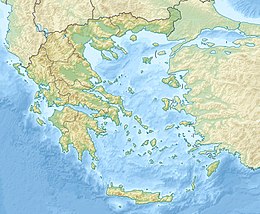|
Kajmakčalan
Kajmakčalan (Kaimakchalan), Kaimaki, Kaimaktsalan or Voras (Greek: Καϊμακτσαλάν or Καϊμάκι or Βόρας, Macedonian: Каjмакчалан, romanized: Kajmakčalan), is a mountain on the border between Greece and North Macedonia. It is the southernmost and highest peak, 2,521 metres (8,271 ft),[2] of a range known in Greek as the Voras Mountains and in Macedonian as Nidže. In terms of prominence, the Kaimaktsalan summit rises 1,758 metres above its surroundings. The frontier between the two countries runs across the summit.[1] It is the third-highest peak in Greece after Mytikas and Smolikas and the fifth-highest in North Macedonia.[citation needed] EtymologyThe word "Kajmakčalan" is of Ottoman Turkish origin and inspired by its white, snowy peak: kaymakçalan means 'kaymak-like'. "Kaymak" in Turkish refers to a dairy product similar to clotted cream. GeologyThe peak consists of granite, gneiss and mica. ClimateKajmakčalan has a subarctic climate (Dfc) with short, cool summers and long, cold winters.
HistoryDuring World War I, in September 1916, the Battle of Kajmakčalan between Serbian and Bulgarian troops took place at Kajmakčalan and around the adjacent peaks, resulting in a Serbian victory. There is a small church and crypt for the Serbian soldiers who died in the battle. Near the top of the mountain, on the Greek side, there is a small church named Saint Peters (Sveti Petar in Serbian), the peak itself is called, besides Kajmakčalan, Profitis Ilias (Greek: Εκκλησία Προφήτης Ηλίας).[6] See alsoReferences
External links
|
||||||||||||||||||||||||||||||||||||||||||||||||||||||||||||||||||||||||||||||||||||||||||||||||||||||||||||||||||||||||||||||||||||||||||||||||||||||||||||||||||||||||||||||||||||

